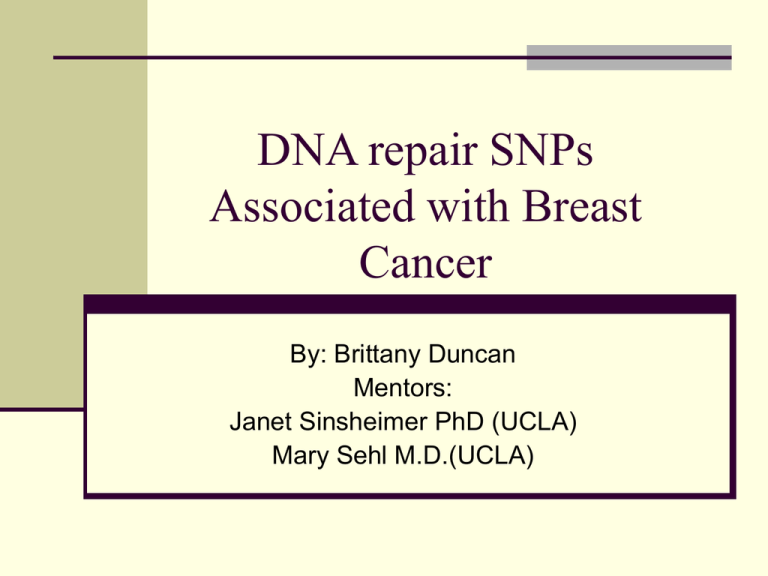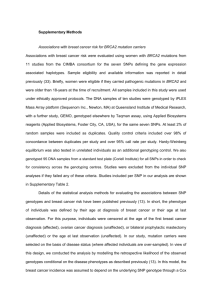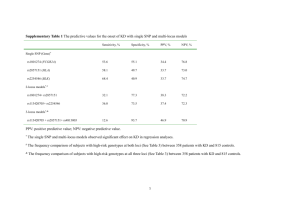- Cal State LA - Instructional Web Server
advertisement

DNA repair SNPs
Associated with Breast
Cancer
By: Brittany Duncan
Mentors:
Janet Sinsheimer PhD (UCLA)
Mary Sehl M.D.(UCLA)
What We Aim to Do
To ultimately determine:
What SNP and Environmental factors
contribute to breast cancer
Whether a combination of SNPs acting
independently might be significant
SNP-SNP interactions associated with
breast cancer
Why is this Important?
Medical:
Determining SNP associations with Breast
Cancer would:
Help predict and prevent future cases
Bioinformatics:
Comparing two analysis techniques will:
Help to create generalized method for analyzing future
SNP interactions
SNP-Single Nucleotide Polymorphism
•A single nucleotide change at
one particular locus
•Must be present in at least
1% of the population
•Can result in genotypic and
phenotypic effects
ACCGTTGTGACCTGCAGTGGAAACAGTATGA
ACCATTGTGACATGCAGTGGAAACAGTGTGA
www.dnalandmarks.com/.../marker_s
ystems_snp.html
Mechanisms of DNA Repair
NER = nucleotide-excision repair, BER = base-excision repair, MMR = mismatch repair, DSBR =double strand break repair,
DRCCD = damage recognition cell cycle delay response, NHEJ = non-homologous end-joining HR = Homologous
Recombination
DSBR pathway
DSBR pathway
Double stranded break repair pathway
One mechanism responsible for the repair and
maintenance of the integrity of DNA
BRCA1 and 2 key elements in this pathway
Vulnerability to breast cancer may be due to an
individual’s capability in repairing damaged DNA
Steps to Success
Recreate
data found in previous paper
Implement Cordell and Clayton:
Stepwise regression method
Write up results and Create tables
Future Direction: Compare results to
Lasso method
UCLA Cancer Registry
UCLA familial cancer registry
Participants may have cancer or not but must
meet these criteria:
Be 18 yrs or older
Two family members with a same type of
cancer or related cancers
Or must have a family history of cancer
susceptibility
Mutation in BRCA1 or BRCA2 gene
http://www.registry.mednet.ucla.edu/
Preliminary Work
Case/control study
399 Caucasian (unrelated) women were chosen
for study
104 SNPs in 17 genes of the DSBR pathway were
chosen
Logistic regression analysis conducted on each SNP
to determine associations with breast cancer
Adjusted models to include covariates
Findings
12 significant SNPs
Confirming Data:
The Process
First Step: Defining Variables
Example of SNP rs16889040 on RAD21 gene, Chromosome 5
Additive
Genotype.
G–G
A–G
A– A
Frequency
199
143
19
DV
+0
+1
+2
Dominant
DV
+0
+1
+1
Additive
• A allele confers risk in having breast cancer and
A-A even more so
Dominant
• A allele confers risk in having breast cancer
regardless of number of copies
Example output from Logistic Regression Dominant Model
rs16889040
Coefficients:
Estimate
(Intercept)
-1.42388
age
0.04464
brca1
0.49067
brca2
-0.11683
EDUCATION1
0.08139
EDUCATION2
0.28671
Ashkenazi_status -0.68789
SNP
-0.76382
Std. Error
0.72444
0.01305
0.39063
0.49631
0.33849
0.34757
0.28608
0.27855
z value
-1.965
3.419
1.256
-0.235
0.240
0.825
-2.405
-2.742
Pr(>|z|)
0.049358
0.000628
0.209079
0.813896
0.809976
0.409424
0.016192
0.006104
Logit(Y) = B0 + B1X1 ….+ Bn Xn
Education
Double-Strand Break
ATM
Non-Homologous
End Joining
TP53
BRIP1
Homologous
Recombination
BRCA1
NBS1
ZNF350
RAD50
XRCC6
BRCA2
XRCC3
RAD51
MRE11A
DNA-PK
XRCC4
H2AX
RAD54L
LIG4
XRCC2
RAD52
H2AX
RAD21
Repaired DNA
XRCC5
Cordell and Clayton Method:
Stepwise Logistic Regression
Stepwise Logistic Regression:
Stepwise logistic regression
Cordell and Clayton Method
used 8 genes that had significant SNPs in
them
Ran forward regression analysis on each gene
Performed LRT and from test found p-value
Cumulative Effects
Cumulative Effects: SNPs in model but act
independently
Findings:
No Accumulation of SNPS were
found significant
Interactive Effects
Multiplicative effects- interaction between SNPs
Findings:
SNPd = rs16888927
SNPf = rs16888997
SNPg = rs16889040
RAD21 Gene interesting but not enough information to be
considered significant
SNPd: SNPf
SNPd: SNPg
SNPf: SNPg
Three way interaction was found to be not
significant
SNP Interactions
Using p-value threshold of 0.05
SNPs
SNPd: SNPf
SNPd: SNPg
OR(eβ)
1.81212
1.76986
p-value
0.090404
0.096392
SNPf: SNPg
1.78383
0.090659
.
Special Thanks
To my amazing mentors at UCLA:
Janet Sinsheimer PhD, Biostatistics lab
Mary Sehl M.D., Dr. Sinsheimer’s lab UCLA
For making the SoCalBSI program possible:
The wonderful mentors at California State Los Angeles
Dr. Momand , Dr. Warter Perez, Dr. Sharp, Dr. Johnston, Mr. Johnston, Dr. Huebach,
Dr. Krilowicz
Program Coordinator
Ronnie Cheng
Funding:
American Society of Clinical Oncology – Mary Sehl
National Science Foundation - SOCALBSI
National Institute of Health - SOCALBSI
Economic and Workplace Development -SOCALBSI
Question Slides
Recoding for Education
Why Use Education?
Why Only Caucasian Women?
LRT/Chi^2
NEHJ and HR
Multiple vs Independent
LRT Test
Three Way Interaction
OR
Lasso Method
Recoding for Education
Logistic Regression
Education: 1-8 answers in a survey
1-3 highest education high school (control)
4-5 some college
6-8 higher education
Educ1
Educ2
0
1
0
1-3
4-5
6-8
0
0
1
μ1 = μ + 0X α1 + 0Xα2
μ2 = μ + 1X α1 + 0X α2
μ3 = μ + 0X α1 + 1X α2
Coded in 0 and 1 transformation from linear to logistic
Linear: Y = B0 + B1X1 ….+ Bn Xn
Logistic: ln[ pi/(1-pin) ] = B0 + B1X1 ….+ Bn Xn
Y == {0,1}
Essentially the log of the probability of the odds
Back
Why Use Education as a Covariate?
Routinely include at least 1 socioeconomic
covariate
Education:
Not necessarily because statistically
interesting, but because other studies have
repeatedly found significance
Back
Why Only White Women?
Homogeneous Population
In different populations (men and other
ethnicities), different genes may be involved
Not enough sampling of any other group
How data was found:
Registry Website and Questionnaire in English
Location of UCLA
Etc…
Back
LRT
Roughly estimated as a chi-squared
distribution
X2= 3.84 for 1 df
P-val = .05
http://www.union.edu/PUBLIC/BIODEPT/chi.html
Back
Cell cycle with NEHJ and HR
GC- use
sister
chromatid
as template
SSAhomologous
sequences
aligned,
residues no
longer
present are
deleted
HR
Alignment and ligation
of termini at DSB
http://www2.mrc-lmb.cam.ac.uk/personal/sl/Html/Graphics/CellCycle.gif
Lord, Garret, Ashworth Clin Cancer Res 2006; 12(15)
Back
Multiple vs. Acting Independently
Cumulative:
Independent
logit(P(Y)) = α + βTz +Ɣ1SNP1 + Ɣ2SNP2
Covariates
Multiplicative:
Combination
of two
logit(P(Y)) = α + βTz +Ɣ1SNP1 + Ɣ2SNP2 +Ɣ3SNP1*SNP2
Back
LRT Test
Testing for which model fits the data better
For a 1 df, 3.84 or higher corresponds to
a p-value of 0.05 or lower
Alternative model fits the data better
Equ: LRT= 2ln(L(HA)/L(H0) )
Less than 3.84
Null model fits the data better
Back
Three Way Interaction
Covariates
logit(P(Y)) = α + βTz +SNPd + SNPf
+ SNPg +SNPd*SNPf*SNPg
Back
ODDS RATIO
Coded in 0 and 1 transformation from linear to logistic
Linear: Y = B0 + B1X1 ….+ Bn Xn
Logistic: ln[ pi/(1-pin) ] = B0 + B1X1 ….+ Bn Xn
Y == {0,1}
Odds Ratio is eB because of Logistic Regression’s
Transformed form
Back
Lasso Penalized Regression
Exploratory method used when large amount
of predictors and small amount of data
Penalizes model for having to many
borderline significant predictors
F(θ) =
1/2Σi(yi
- μ –Σj(xijβj))2 + λΣj| βj |
Least Squares
Penalty Term
Back





